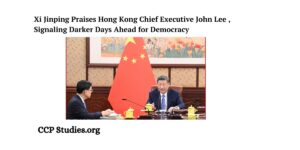
Source: Wikipedia
Content Paraphrased from britannica.com
The following article has been paraphrased from the original content available on britannica.com. For the complete and original article, please visit https://www.britannica.com/topic/Chinese-Communist-Party The credit and accuracy of the information belong to britannica.com. We will publish our own version of CCP history soon.
History The Chinese Communist Party (CCP) was established in 1921 as both a political party and a revolutionary movement by figures like Li Dazhao and Chen Duxiu, who were inspired by the May Fourth Movement and embraced Marxism after the success of the Russian Revolution in 1917. In the turbulent 1920s in China, prominent CCP members, including Mao Zedong, Liu Shaoqi, and Li Lisan, initiated the organization of labor unions in urban areas. The CCP formed an alliance with the Nationalist Party in 1924, initially successful but eventually leading to conflict in 1927 when the Nationalists, led by Chiang Kai-shek, violently turned against the communists, forcing them underground.
Following the suppression, CCP cadres, such as Mao, shifted their focus to the countryside, where they gained significant support from peasants. In 1931, the Chinese Soviet Republic was established in southern China, but it was later dismantled by Nationalist military campaigns. Mao and his forces embarked on the Long March (1934–35) to Yan’an in northern China, where Mao assumed a leadership position within the CCP.
During the Xi’an Incident in 1936, Chiang Kai-shek had to halt his campaigns against the CCP and form a United Front with them against Japanese aggression. While the Nationalists remained inactive in Chongqing during the war, the CCP expanded its strength by actively resisting the Japanese invaders. By the war’s end in 1945, the CCP controlled base areas with a population of around 100 million and had a well-established army and political program.
The civil war resumed in 1946, with the CCP’s land-reform program gaining support from peasants, while the Nationalists faced demoralization. In 1949, after the decisive defeat of the Nationalists, the CCP and its allies established the People’s Republic of China.
Subsequent years saw disagreements within the CCP over the country’s development. Initially aligning with the Soviet model, the CCP diverged from the Communist Party of the Soviet Union (CPSU) over foreign policy and ideology. In the late 1950s, the CCP implemented bold, sometimes detrimental, programs for China’s industrial development, including the Great Leap Forward (1958–60).
In 1966, Mao initiated the Cultural Revolution, leading to internal struggles between the radical wing under Mao and the pragmatic wing led by Liu Shaoqi and Deng Xiaoping. The Cultural Revolution ended in 1976 with the death of Mao, and Deng Xiaoping assumed paramount power. The “Four Modernizations” program was adopted, relaxing restrictions on art and education while de-emphasizing revolutionary ideology.
After Mao’s death, Hua Guofeng served as party chairman until 1981, followed by a succession of leaders, including Deng’s proteges Hu Yaobang, Zhao Ziyang, Jiang Zemin, Hu Jintao, and Xi Jinping, who became the general secretary in 2012.




